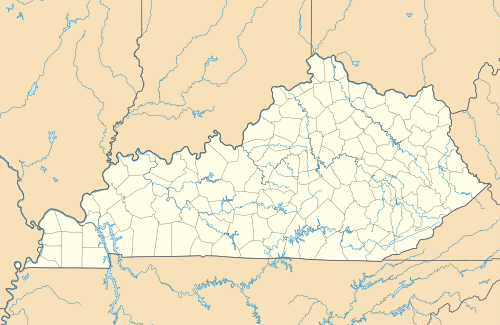Phillips' Folly
Phillips' Folly is a 2 1⁄2-story painted brick house in Maysville, Kentucky. The architecture displays a blend of styles which may be explained, in part, by the six-year construction period. The Sutton Street entrances are Federal, windows are typically Greek Revival in their size, and the two-tiered portico and the segmental dormers reflect a Georgian influence. The portico and Doric frieze are similar to Drayton Hall (1738–42) near Charleston, South Carolina.[1] The stepped parapets on the end walls are peculiar to the Ohio River valley and are "associated with the "Dutch" character of Cincinnati and the surrounding area".[2] The mortarless stone basement is in good repair.
Phillips' Folly | |
 | |
  | |
| Location | 227 Sutton St., Maysville, Kentucky |
|---|---|
| Coordinates | 38°38′51″N 83°46′3″W |
| Built | 1825–1831 |
| Architectural style | Greek Revival, Federal, Gerogian |
| NRHP reference No. | 78001383[1] |
| Added to NRHP | August 10, 1978 |
William B. Phillips was Maysville's second mayor and was among those who welcomed General Lafayette during his 1825 Maysville visit. Phillips is listed as being Mason County's state legislator in 1820. Phillips's Third Street residence earned the term "folly" because he started it in 1825, but ran out of funds, causing construction to halt. "Leaving the house unfinished, the owner disappeared for two years, during which time he won enough money (in New Orleans) at gambling to complete the structure".[3]
Phillips sold his "folly" to wholesaler John Armstrong, and Phillips is not included in the 1850 census of Maysville. In the late 19th-century, the house was the residence of Dr. John A. Reed and his family. Dr. Reed maintained a medical practice in the basement and was the father of Associate Supreme Court Justice, Stanley Forman Reed.[3]
According to oral history, the house was a stop on the Underground Railroad. The runaway slaves were held in a wooden cell on the lower level until it was safe for them to continue their journey to the Ohio River, which was nearby, on their way to freedom. It is believed the slaves were kept in a cell in case slave hunters came to the house and if caught having the runaway slaves in their home, they could say they were holding the slaves to avoid being charged with trying to free slaves. A tunnel that the slaves were thought to have used to escape to nearby Ohio River can still be seen in the lower level of the house. The cell is also thought to have been the town jail at one time.
In March 2011, Ghost Adventures from the Travel Channel filmed at Phillips' Folly. The episode aired on Friday May 13, 2011. It featured current owner and Underground Railroad historian, Jerry Gore. Phillips' Folly is said to be haunted by William B. Phillips and his dog, by a guest of the house who committed suicide while staying there and the ghosts of slaves who were tortured and murdered in a makeshift jail in the basement of the building.
References
- "National Register of Historic Places Inventory Nomination Form". National Register of Historic Places. National Park Service. Retrieved 2011-01-08.
- Sarah Lansdell, "Heritage Homes of Maysville," The Courier-Journal and Times Magazine, Sunday, August 5, 1973, p.16
- Sarah Lansdell, p. 19